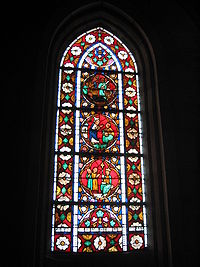
Saint-Dié Cathedral
Encyclopedia

France
The French Republic , The French Republic , The French Republic , (commonly known as France , is a unitary semi-presidential republic in Western Europe with several overseas territories and islands located on other continents and in the Indian, Pacific, and Atlantic oceans. Metropolitan France...
, located in the town of Saint-Dié-des-Vosges
Saint-Dié-des-Vosges
Saint-Dié-des-Vosges, commonly referred to as Saint-Dié, is a commune in the Vosges department in Lorraine in northeastern France.It is a sub-prefecture of the department.-Geography:...
in Lorraine
Lorraine (région)
Lorraine is one of the 27 régions of France. The administrative region has two cities of equal importance, Metz and Nancy. Metz is considered to be the official capital since that is where the regional parliament is situated...
.
It is the seat of the Bishop of Saint-Dié, created in 1777.
Building description
The cathedral, like most of the town, is built largely of the local red sandstoneSandstone
Sandstone is a sedimentary rock composed mainly of sand-sized minerals or rock grains.Most sandstone is composed of quartz and/or feldspar because these are the most common minerals in the Earth's crust. Like sand, sandstone may be any colour, but the most common colours are tan, brown, yellow,...
. It has a Romanesque
Romanesque architecture
Romanesque architecture is an architectural style of Medieval Europe characterised by semi-circular arches. There is no consensus for the beginning date of the Romanesque architecture, with proposals ranging from the 6th to the 10th century. It developed in the 12th century into the Gothic style,...
nave (12th century) and a Gothic
Gothic architecture
Gothic architecture is a style of architecture that flourished during the high and late medieval period. It evolved from Romanesque architecture and was succeeded by Renaissance architecture....
choir; the portal of red stone dates from the 18th century. A fine cloister (13th century), containing a stone pulpit, communicates with the Petite-Église or Notre-Dame de Galilée, a well-preserved specimen of Romanesque architecture (12th century).
History

Deodatus of Nevers
Deodatus of Nevers was a bishop of Nevers from 655. Deodatus lived with Arbogast in the monastery of Ebersheim, established by Childeric II near Sélestat in the forest of Hagenau....
, the eponymous Saint Dié, founded a monastery here in the 7th century and gave up his episcopal functions to retire to this place.
In the 10th century the community became a chapter of canons
Canon (priest)
A canon is a priest or minister who is a member of certain bodies of the Christian clergy subject to an ecclesiastical rule ....
. Among those who subsequently held the rank of provost or dean were Giovanni de Medici, afterwards Pope Leo X
Pope Leo X
Pope Leo X , born Giovanni di Lorenzo de' Medici, was the Pope from 1513 to his death in 1521. He was the last non-priest to be elected Pope. He is known for granting indulgences for those who donated to reconstruct St. Peter's Basilica and his challenging of Martin Luther's 95 Theses...
, and several princes of the ducal House of Lorraine
House of Lorraine
The House of Lorraine, the main and now only remaining line known as Habsburg-Lorraine, is one of the most important and was one of the longest-reigning royal houses in the history of Europe...
. Among the extensive privileges enjoyed by them was that of coining money.
Though they co-operated in building the town walls, the canons and the dukes of Lorraine soon became rivals for authority over the town of Saint-Dié, where towards the end of the 15th century one of the earliest printing presses of Lorraine was founded. The institution of a town council in 1628, and the establishment in 1777 of the bishopric which appropriated part of their spiritual jurisdiction, contributed greatly to diminish the influence of the canons; and with the French Revolution
French Revolution
The French Revolution , sometimes distinguished as the 'Great French Revolution' , was a period of radical social and political upheaval in France and Europe. The absolute monarchy that had ruled France for centuries collapsed in three years...
they were completely swept away. Their church remains as the cathedral.

